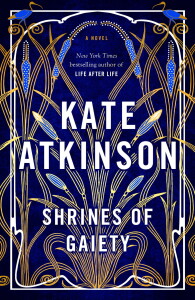
The story opens with the infamous Nellie Coker, owner of a string of nightclubs in 1926 London, being released from Holloway Prison at dawn. Many of the toffs and high-ranking politicians who revel at her clubs and who conspired with her in evading police scrutiny are present, a bit bedraggled by their long night dancing and drinking, to celebrate Nellie’s release, along with “the usual riffraff and rubberneckers.”
Nellie immediately has to buckle down and defend her empire from several threats.
Meanwhile Detective Chief Inspector John Frobisher, on loan to Bow Street to “root out corruption,” is one of those threats, though he is hampered by the distrust of his new colleagues, the distraction of a string of drownings of young girls, and his own ineffectual nature. He is unhappily married to a mentally ill woman; he’s not really sure why he married her except that he prevented her from jumping off a bridge.
With characteristic humor, Atkinson vividly depicts the London club scene of the time. The aftermath of the Great War is everywhere in this story, from wartime reminiscences of the doorman to the difference between men who had gone to war and those who had not. Even the reckless abandon of 1920s London is blamed on a reaction to the war.
The criminal elements are mostly played for laughs. This bumbling cast of villains reinforces Hannah Arendt’s idea of the banality of evil. Writers don’t come off much better. Frobisher’s articles requested by John Bull are never published because they are not sensational enough. Ramsey Coker wants to be a best-selling author, but is too lazy to actually write.
Atkinson has done her research on this period. However, this novel illustrates the danger of too much research. I found it an unsatisfying story of uninteresting characters.
It also illustrates the danger of using real people and their lives for a story. Real people the author only knows from reading about them don’t necessarily make for interesting characters. There’s too little detail, nothing that makes them stand out. Frobisher, “influenced” by real-life Superintendent Robert Fabian and Nellie Coker, based on the real “queen of Soho’s clubland” Kate Meyrick, never quite come to life in this story.
Nellie’s obnoxious brood seem like empty caricatures put in place for plot purposes. The two 14-year-old girls who run away to London are stock characters. There’s a prostitute with a heart of gold, two policemen on the take, a strict battleax running a hotel for women, and so on.
Only the third protagonist, fictional Gwendolen Kelling, a former librarian who has come to London in search of the two lost girls, steps off the page, displaying real emotion and unexpected competencies. A nurse during the war, she is more than equal to London’s recklessness.
The other danger of using real lives is that they rarely fit into the kind of narrative arc readers expect. Here, plot threads are abandoned without being resolved; story questions are not answered; important events are random happenings rather than growing organically out of the characters and the plot. True, a couple of threads and questions are dispatched, but too much is left unresolved for there to be a satisfactory ending.
I had to wonder why I should care about these characters and their lives when the author seemed to care so little that she would just abruptly abandon them.
Just like real life, you might say. True. And it is somewhat interesting as an experiment. Atkinson is not alone among authors questioning whether standard story structures adequately represent our lives in this world. I appreciate her willingness to tinker with the balance between reality and story. Still, it was too insubstantial a story to satisfy me.
Have you read an historical novel that includes real people as characters? What did you think of it?
